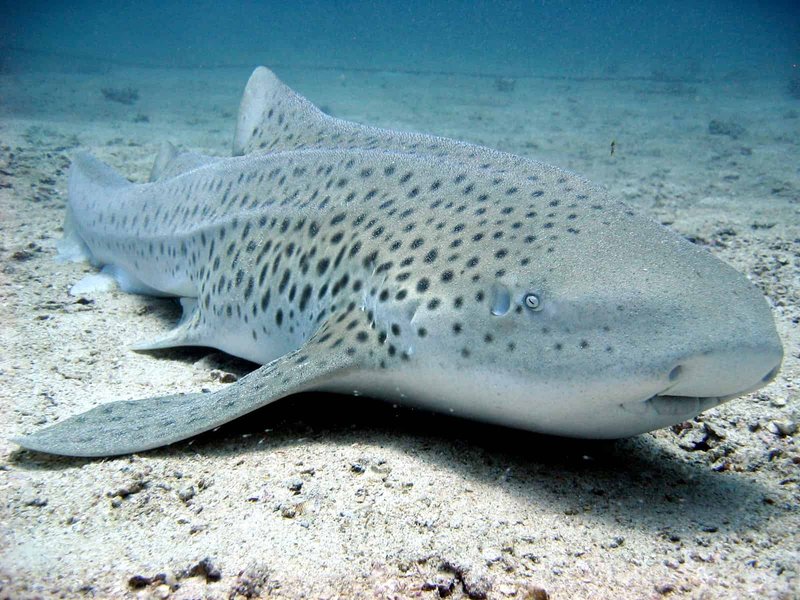
Imagine chilling at the beach, enjoying the sun, and then suddenly coming across a zebra shark gliding gracefully along the ocean floor. You might feel a mix of excitement and apprehension. Honestly, the idea of swimming with sharks sounds thrilling, but safety is definitely a priority. So, let’s explore how humans can safely interact with zebra sharks, what precautions you should take, and a bit about their behavior in case you encounter one.
Understanding the Zebra Shark’s Nature
The zebra shark, also known as *Stegostoma fasciatum*, is a fascinating species found primarily in the warm waters of the Indo-Pacific. They are called zebra sharks because of the distinctive stripes they have as juveniles, which turn into spots as they grow older. These sharks can grow up to 11 feet long but mostly spend their time resting on the ocean floor.
Here’s the thing: zebra sharks are generally considered docile compared to other shark species. They mainly feed on small fish, mollusks, and crustaceans. Because of their calm nature, they’re often found in shallow waters, making them a popular choice for divers and snorkelers. However, like all wild animals, they can exhibit unpredictable behavior if threatened, which is why understanding their nature is crucial for safe interaction.
You might be wondering how their anatomy supports their behavior. Zebra sharks have a unique body shape and an elongated, flattened head that helps them camouflage among rocks and corals. This not only makes them good ambush predators but also allows them to blend in with their environment, which can be a crucial factor when interacting with them in the wild.
Where Are Zebra Sharks Found?
Zebra sharks prefer warm, shallow waters in the Indo-Pacific region. You can commonly find them in coral reefs, sandy bottoms, and lagoons. Certain areas, like the Great Barrier Reef in Australia, are well-known habitats for these sharks. When planning a swim, always research the specific location—some might be more populated with zebra sharks than others.
In addition to natural habitats, zebra sharks are often kept in aquariums where visitors can safely observe them. Facilities like the Georgia Aquarium or the Monterey Bay Aquarium feature these sharks in their exhibits. Here, you can watch them glide gracefully while learning more about this unique species and what it takes to keep them thriving in captivity.
If you’re keen to see these sharks up close, consider a guided tour with certified dive instructors. They can provide valuable insights into zebra shark behavior and help you interact with them safely.
Best Practices for Safe Interaction
If you’re lucky enough to encounter a zebra shark while diving or snorkeling, there are some best practices for safe interaction. First and foremost, keep your distance. Respecting their space is essential for both your safety and the shark’s. Approaching too closely can stress the animal and disrupt its natural behavior.
Here are some practical tips to keep in mind during your encounter:
- Stay calm: Sudden movements can startle the shark.
- Avoid touching: It’s essential to resist the urge to pet or touch them.
- Observe quietly: Enjoy the experience while staying low and still.
- Follow your guide’s instructions: If you’re with an instructor, they’ll provide guidance on what to do and what not to do.
By following these practices, you increase your chances of having a safe and enjoyable interaction with the zebra shark. Remember, they’re wild animals and should be respected as such.
The Benefits of Interacting with Zebra Sharks
Interacting with zebra sharks can be an enriching experience, offering benefits beyond just a fun swim. For one, it provides a chance to learn about marine ecosystems. Observing a zebra shark in its natural habitat gives you insight into its role within the reef and helps foster a deeper appreciation for ocean conservation.
Another benefit is the opportunity for personal growth. Swimming with these sharks can push you outside your comfort zone and provide a sense of accomplishment. It’s not often you can say you swam with a shark, right? Sharing this experience with friends or family can strengthen bonds and create lasting memories.
Plus, there’s a growing community of shark enthusiasts. Engaging with like-minded individuals can expand your knowledge and passion for marine life. Joining forums, attending events, or participating in conservation programs can deepen your relationship with the ocean and its inhabitants.
Potential Risks and Precautions
While zebra sharks are generally gentle, it’s important to acknowledge the potential risks involved when interacting with any wildlife. Even though zebra sharks are not known to be aggressive, accidents can happen. Therefore, it’s essential to take precautions.
Before entering the water:
- Check local regulations: Some areas may have specific rules about interacting with marine life.
- Be aware of your surroundings: Look out for currents, weather conditions, and other marine life.
- Wear appropriate gear: A wetsuit can offer protection against scrapes and possible encounters with other marine animals.
Also, if you’re a beginner or unsure about your swimming skills, consider taking lessons first or going with an experienced group. It’s all about ensuring your safety while enjoying the wonders of the ocean.
Training and Conservation Efforts
Zebra sharks play a vital role in maintaining the health of marine ecosystems. Many conservation organizations focus on educating the public about the importance of these sharks and protecting their habitats. You can often find training programs that teach safe snorkeling and diving practices while promoting responsible interaction with marine wildlife.
Furthermore, visiting marine parks or supporting conservation initiatives can help fund vital research and habitat protection efforts. Joining volunteer programs or participating in beach clean-ups can also contribute to preserving the environment that zebra sharks call home.
By working together as a community, we can ensure that future generations can enjoy experiencing these beautiful creatures in their natural habitats.
Interacting safely with zebra sharks is not just possible; it can be an unforgettable experience. By understanding their nature, where to find them, and the best practices for interaction, you can enjoy these majestic creatures in a respectful and safe manner.
Always remember to prioritize safety, respect their space, and appreciate the beauty of the ocean’s ecosystems. Whether you’re diving into a coral reef or observing them in an aquarium, zebra sharks offer a unique glimpse into the wonders of marine life. So next time you think about exploring the underwater world, keep the zebra shark in mind!

